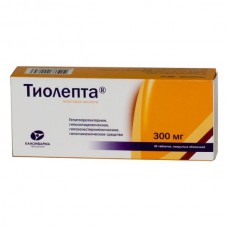Expiration date: 09/2026
The composition and form of issue:
Tablets, film-coated 1 tablet contains active substance:
thioctic acid (alpha lipoic acid) 300 mg
excipients: starch potato silica colloidal anhydrous (Aerosil A-300) croscarmellose sodium (Primerose) calcium stearate lactose (milk sugar) MKC castor oil
shell: selichot AQ-01812 (hypromellose (hydroxypropylmethylcellulose), macrogol 400 (polyethylene glycol 400), macrogol 6000 (polyethylene glycol 6000), titanium dioxide, dye iron oxide yellow, quinoline yellow dye)
in a contour acheikova packing of PVC film and aluminum foil printed patent 10 or 15 PCs per stack of cardboard 1, 3, 6, 9 packs (10 PCs.) or 2, 4, 6 packs (15 pieces each).
Tablets, film-coated 1 tablet contains active substance:
thioctic acid (alpha lipoic acid) 600 mg
auxiliary substances: calcium stearate starch potato silica colloidal anhydrous (Aerosil) croscarmellose sodium (Primerose) lactose (milk sugar) castor oil, povidone (kollidon 30) MKC
shell: selichot ?Q-01812 (hypromellose (hydroxypropylmethylcellulose), macrogol (polyethylene glycol 400), macrogol (polyethylene glycol 6000), titanium dioxide, dye iron oxide yellow, quinoline yellow dye)
in a contour acheikova packing of PVC film and aluminum foil printed patent 10 or 15 PCs per stack of cardboard 1, 3, 6, 9 packs (10 PCs.) or 2, 4, 6 packs (15 pieces each).
Solution for infusion 1 ml contains active substance:
thioctic acid (alpha lipoic acid) 12 mg
excipients: meglumine (N-methyl-D-glucamine) — 15 mg macrogol (polyethylene glycol 400) 30 mg povidone (kollidon 17 PF or plasmon-15) — 10 mg water for injections to 1 ml
theoretical osmolarity — 269 mOsm/l
in vials of glass of 1st hydrolytic class brown to 25 ml in a cardboard pack of 1, 3 or 5 bottles together with hanging lens case.
Description pharmaceutical form:
Tablets 300 mg: tablets, coated light yellow, round, biconvex shape.
Tablets 600 mg: tablets, film-coated light yellow, oval. On the fracture of the tablets of light yellow color.
Solution for infusion: clear, light yellow or light yellow to greenish solution.
Pharmacokinetics:
When ingestion rapidly and completely absorbed in the digestive tract, taken along with food reduces absorption. The time to reach Cmax — 40-60 min. Bioavailability of 30%.
Has the first pass effect through the liver. Metabolized in the liver by oxidation of the side chain conjugation. Vd — 450 ml/kg Total plasma clearance of 10-15 ml/min. Thioctic acid and its metabolites are excreted by the kidneys (80-90%). T1/2 — 20-50 min.
At/in the introduction of the time to reach Cmax is 10-11 min, AUC is about 5 µg·h/ml.
Description pharmacological action:
Thioctic acid (alpha lipoic acid) is an endogenous antioxidant (free radicals) in the body formed by oxidative decarboxylation of alpha-ketoacids. As a coenzyme of mitochondrial multienzyme complexes involved in oxidative decarboxylation of pyruvic acid and alpha-keto acids. The nature of the biochemical action similar to the b vitamins Improves trophism of neurons. Has hepatoprotective, hypolipidemic, hypocholesterolemic, hypoglycemic effect. Contributes to decrease the content of blood glucose and increased glycogen content in the liver, as well as reducing insulin resistance. Involved in the regulation of lipid and carbohydrate metabolism, stimulates cholesterol metabolism, improves liver function.
Solution for infusion (optional)
The inclusion in the composition of the solution of thioctic acid meglumine having a neutral reaction, can reduce the severity of adverse reactions.
Indications:
- Diabetic and alcoholic polyneuropathy.
Contraindications:
- hypersensitivity to the drug
- pregnancy, breastfeeding (insufficient experience with the drug)
- children up to age 18 years (efficacy and safety not established).
Tablets (optional)
lactose intolerance, lactase deficiency, glucose-galactose malabsorption.
Side effects:
Pills
Gastrointestinal: nausea, heartburn, vomiting, diarrhea, abdominal pain.
Allergic reactions: hives, skin rash, itching.
May develop hypoglycemia (in connection with the improvement of glucose utilization), symptoms of which include dizziness, sweating, headache, visual disturbances.
Solution for infusion
After the on/in the introduction of possible seizures, diplopia petechial hemorrhages in the mucous membranes, skin, thrombocytopenia, hemorrhagic rash (purpura), thrombophlebitis during rapid injection may increase intracranial pressure (feelings of heaviness in the head) shortness of breath. These side effects are themselves. Allergic reactions: urticaria, systemic allergic reactions (up to anaphylactic shock). May develop hypoglycemia (in Association with improved glucose uptake).
Drug interactions:
While the use of thioctic acid and cisplatin there is a decrease in the effectiveness of cisplatin. Thioctic acid binds metals, so it should not be used in conjunction with drugs containing metals (e.g. iron preparations, magnesium, calcium). After taking the drug the morning Tialata to use drugs iron, magnesium, and eat dairy products (because of the content of calcium) is recommended after lunch or in the evening.
While the use of thioctic acid and insulin or oral hypoglycemic drugs their effects can be intensified, so it is recommended that regular monitoring of the concentration of glucose in the blood, especially at the beginning of therapy of thioctic acid. In some cases, the allowed reduction in the dose of hypoglycemic medications to avoid the development of symptoms of hypoglycemia.
Infusion solution of thioctic acid is incompatible with dextrose solution, ringer solution and solutions that react with disulfide and SH-groups of the ethanol.
Ethanol and its metabolites attenuate the action of thioctic acid.
Method of application and dose:
Pills
Inside, 600 mg 1 time per day.
Take pills on an empty stomach approximately 30 minutes before the first meal, with liquid squeezed small amount of liquid. The duration of treatment determined by the physician.
Solution for infusion
In/in the drip, 600 mg (50 ml of 12 mg/ml) 1 time per day administered in severe forms of diabetic and alcoholic polyneuropathy. In the beginning of the course the drug is injected in/in in 2-4 weeks. Then possible transition to the oral form of the drug (tablet) in the dose of 600 mg per day. The drug should be administered slowly, not exceeding 50 mg thioctic acid for 1 min. on/In the introduction is possible via perfusor (duration of administration — not less than 12 min).
In applying the drug in the vials with the infusion solution placed in the supplied pendant light-protective cases, made of PE black color.
Overdose:
Symptoms: headache, nausea, vomiting.
In case of acute overdose (when using 6-40 g for adults or 50 mg/kg for a child) may experience severe signs of intoxication (generalized seizures marked disorders of acid-base balance, leading to lactic acidosis hypoglycemic coma severe blood clotting, causing sometimes fatal) required immediate hospitalization.
Treatment: symptomatic, if necessary, anticonvulsant therapy, measures to maintain vital functions. There is no specific antidote.
Special instructions:
Patients with diabetes requires constant monitoring of glucose concentration in the blood, especially at the initial stage of therapy. In some cases it is necessary to reduce the dose of insulin or oral hypoglycemic medication to avoid hypoglycemia.
During treatment, patients should refrain from alcohol and be careful when driving and occupation of other potentially hazardous activities, require increased attention and rapid mental and motor reactions.




